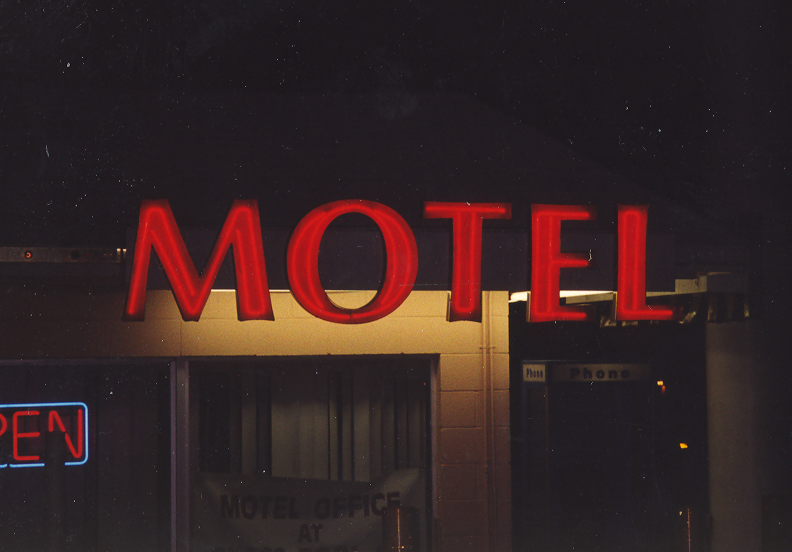
The Mint Hotel designed by Walter Zick and Harris Sharp
He was one of the most prolific architects in Las Vegas. Walter Zick, along with his partner Harris Sharp, designed some of the coolest mid-century modern buildings in Southern Nevada. His best known design is probably also the most-beloved, the fabulous Mint Hotel. It's design fulfilled the optimistic potential that was pervasive across America in the late 1950s and the early 1960s. In that canyon of neon called Glitter Gulch, the Mint sat shoulder to shoulder with fanciful facades that depicted the Barbary Coast (The Golden Nugget), the Wild West (The original California Club) and San Francisco (The Golden Gate).
Wayne McAllister's design of the Fremont Hotel may have been the first mid-century modern casino on Fremont Street but Zick and Sharpe saw that design and raised the stakes. Working with YESCO's top designers, Kermit Wayne and Hermon Boergne, the facade of the Mint was one of the first to explore the three dimensional aspects of neon. It's eye-poping pink and white neon took your breath away.
If the Mint was all that Zick and Sharp had designed in Las Vegas that would be enough. But thanks to Friends of Classic Las Vegas commercial chair Mary Martinez and our favorite downtown neighborhood blogger, Jack LeVine, I have been given a disc of images and information on the life and works of Walter Zick. His family is trying to get a school named for him and though their initial request was turned down, we are thrilled to be joining with VeryVintageVegas to help spotlight Zick's accomplishments and keep the idea of a school named in his honor alive.
Walter Zick designed more than just casinos and hotels. I grew up in Charleston Heights which sports many of the schools and commercial buildings that he designed. I am familiar with Hyde Park Junior High School which was the first air-conditioned school in the nation. My brother was born at Southern Nevada Hospital in the mid-1960s when it sported a Zick and Sharp mid-century facade. I attended junior high school at Garside, which they designed. I attended high school at Ed. W. Clark High School which was designed by Zick and Sharp. They designed both Western High School and Valley High School, both cross-town rivals of Clark. We attended football games every Friday night at the Sam Boyd Silver Bowl, again designed by Zick and Sharp.
After I graduated in 1975, I attended UNLV and had a Shakespeare class in the Humanities Building that Zick designed. The Maude Frazier Building, the first building on the campus when it opened in 1958 was designed by them.
We did our banking at the corner of Charleston and Decatur at the Bank of Las Vegas and the First National Bank of Nevada both designed by Zick and Sharp. The Foley Federal Building which was built next to the 5th Street Grammar School where I attended kindergarten was also designed by them. The Clark County Courthouse near the Foley Federal Building is their design.
I remember the Nevada Savings and Loan Headquarters, the Nevada State Bank near then-popular Spanish Oaks, Western Airlines terminal, the Westgate Shopping Center, the YMCA addition.
In addition to the Mint, he designed the Bird Cage Casino which sat just west of the Mint and was ultimately annexed by the hotel and he and Sharp designed the famous "eyebrow" addition. They helped complete Wilbur Clark's Desert Inn, had a hand in the remodel of the El Rancho Vegas, designed the first integrated hotel and casino, the Moulin Rouge as well as the Union Plaza and many more.
He also designed residential homes for some of the biggest movers and shakers in Las Vegas including Benny Binion, the Cashman family, Marcus Daly (whose rec room included a below ground bomb shelter, a bowling alley and a movie theater), architect Bill Moore's house, Mayme Stocker's house on Bracken Avenue, Joseph Switzer's house and Ted Weins as well.
We'll hopefully have more on Walter Zick in the days and weeks ahead so keep an eye out here!

Destroyed for a Walgreens.

The Moulin Rouge (with signage by Betty Willis) before the fire of 2003.
Special thanks to RoadsidePictures for letting use this image.
Special thanks to the family of Walter Zick for letting us highlight his life.
Special thanks to Mary Martinez and Jack LeVine for the disc!
















